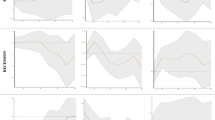Abstract
The global financial crisis and the attendant Great Recession of 2007–2009 have spawned a full-scale re-examination on the effectiveness of fiscal policy throughout the world. While this has led to a plethora of analyses in developed countries, the same abundance of the work has not been evident for developing counties. This paper uses time-series analysis to examine the multiplier impact of fiscal policy on growth and other macroeconomic variables in the case of four Caribbean states. Although these countries have similar degrees of openness, they differ in debt burdens and economic structures, thus providing a natural laboratory for this investigation. We concluded that fiscal multipliers among the sample countries are quite low and that the contemporaneous fiscal stance appears to be pro-cyclical.
Similar content being viewed by others
Notes
Similarly, \( v_t^y \),\( v_t^p v_t^m \), \( v_t^c \) and \( v_t^r \) would be the structural orthogonal shocks in the output, prices, imports, private consumption, and the 90-day Treasury bill rate.
Several approaches were considered for deriving the output gap including: the linear trend method, the quadratic approach, the Hoderick-Prescott filter and the Fixed length symmetric (Christiano-Fitzgerald) Band-Pass Filter.
We also investigated government expenditure cycles and revenue cycles independently and found a similar result for government expenditure cycles. Result using revenue cycles were only showed contemporaneous effects with a positive coefficient. Details can be provided on request.
The Unit root test, lag selection criteria test, and the results of the unrestricted VAR are available on request.
The cumulative dynamic multiplier at a given quarter is obtained as the ratio of the cumulative response of GDP and the cumulative response of government expenditure (de Castro and Hernandez de Cos 2008).
References
Belgrave, A., & Craigwell, R. (1995). The impact of government expenditure on economic growth in a small Caribbean economy: a disaggregated approach. Central Bank of Barbados Working Papers.
Blanchard, O. J., & Perotti, R. (2002). An empirical characterization of the dynamic effects of changes in government spending and taxes on output. Quarterly Journal of Economics, 117(4), 1329–1368.
Bynoe, R., & Maynard, T. (2008). The Barbados case: fiscal shocks and economic output. Central Bank of Barbados Working Papers.
Carmignani, F. (2010). Cyclical fiscal policy in Africa. Journal of Policy Modeling, 32, 254–267.
Coenen, G., Erceg, C., Freedman, C., Furceri, D., Kumhof, M., Lalonde, R., et al. (2010). Effects of fiscal stimulus in structural models. IMF Working Paper, WP/10/73.
Cogan, J. F., Cwik, T., Taylor, J. B., & Wieland, V. (2009). New Keynesian versus old Keynesian government spending multipliers. Journal of Economic Dynamics and Control, 34, 281–295.
Congressional Budget Office. (2010). Estimated Impact of the American Recovery and Reinvestment Act on Employment and Economic Output from October 2009 through December 2009.
Craigwell, R., & Rock, L. (1991). Evaluating the Buchanan-Wagner Hypothesis evidence from Caribbean Countries. Social and Economic Studies, 40(3), 41–58.
de Castro, F., & Hernandez de Cos, P. (2008). The economic effects of fiscal policy: the case of Spain. Journal of Macroeconomics, 30, 1005–1028.
Eskesen, L. L. (2009). The role of counter-cyclical fiscal policy in Singapore. IMF Working Paper WP/09/8.
Fatas, A., & Mihov, I. (2001). Government size and automatic stabilizers: international evidence. Journal of International Economics, 55, 3–28.
Gali, J. (1994). Government size and macroeconomic stability. European Economic Review, 38, 117–132.
Gali, J., Lopez-Salido, D., & Valles, J. (2007). Understanding the effects of government spending on consumption. Journal of the European Economic Association, 5, 227–270.
Giordano, R., Momigliano, S., Neri, S., & Perotti, R. (2007). The effects of fiscal policy in Italy: evidence from a VAR model. European Journal of Political Economy, 23, 707–733.
Greenidge, K., & Da Costa, D. (2009). Determinants of inflation in selected Caribbean countries. Journal of Business, Finance and Economics in Emerging Economies, 4(2), 371–396.
Hemming, R., Kell, M., & Mahfouz, S. (2002). The effectiveness of fiscal policy in stimulating economic activity—a review of the literature. IMF Working Paper.
Hsiao, C., Pesaran, H. M., & Tahmiscioglu, A. K. (2002). Maximum likelihood estimation of fixed effects dynamic panel data models covering short time periods. Journal of Econometrics, 109, 107–150.
Ilzetzki, E., & Vegh, C. A. (2008). Procyclical fiscal policy in developing countries: truth or fiction? NBER Working Paper Series 14191.
Ilzetzki, E., Mendoza, E. G., & Vegh, C. A. (2009). How big are fiscal multipliers? Centre for Economic Policy Research Policy Insight No. 39.
Marinheiro, C. F. (2008). The stability and growth pact, fiscal policy institutions and stabilization in Europe. IEEP, 5, 189–2007.
Nijkamp, P., & Poot, J. (2004). Meta-analysis of the effect of fiscal policies on long-run growth. European Journal of Political Economy, 20, 91–124.
Perotti, R. (2004). Estimating the effects of fiscal policy in OECD countries. In: Proceedings, Federal Reserve Bank of San Francisco.
Pesaran, H. M., & Smith, R. (1995). Estimating long-run relationships from dynamic heterogenous panels. Journal of Econometrics, 68, 79–113.
Tagkalakis, A. (2007). The effects of fiscal policy on consumption in recessions and expansions. Journal of Public Economics, 92, 1486–1508 (2008).
Author information
Authors and Affiliations
Corresponding author
Appendix
Appendix
Rights and permissions
About this article
Cite this article
Guy, K., Belgrave, A. Fiscal Multiplier in Microstates: Evidence from the Caribbean. Int Adv Econ Res 18, 74–86 (2012). https://doi.org/10.1007/s11294-011-9338-8
Published:
Issue Date:
DOI: https://doi.org/10.1007/s11294-011-9338-8




